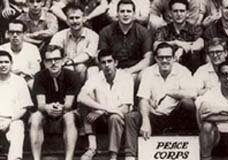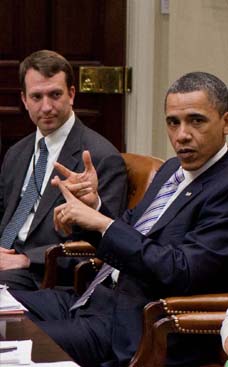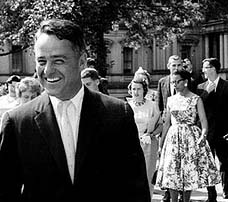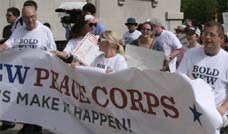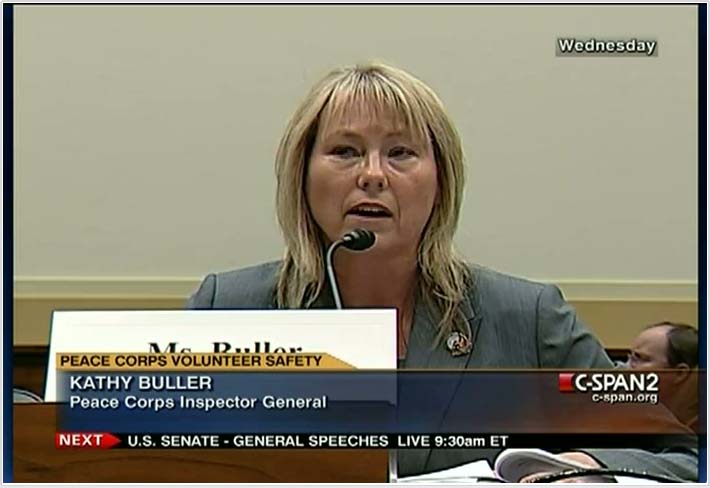
"The agency is making progress in confronting some of its challenges and has worked to streamline operations and improve the technology that supports key business processes and critical Volunteers support areas. The agency is taking important steps to modernize and become more efficient. The implementation of DOVE promises to substantially improve the ability of the agency to match posts' program needs with Volunteer applicant profiles, resulting in better Volunteer placement. Increased management oversight over Volunteer safety and security and Volunteer medical care will support greater consistency of quality over these critical support services. The agency must continue to evolve and ensure its business processes reflect the activities of today's Peace Corps, not the agency that was founded fifty years ago."
Testimony of Peace Corps Inspector General Ms. Kathy A. Buller: "Peace Corps: The Next Fifty Years"
U.S. SENATE COMMITTEE ON FOREIGN RELATIONS
SENATE SUB-COMMITTEE ON WESTERN HEMISPHERE, PEACE CORPS, AND GLOBAL NARCOTICS
OCTOBER 6, 2011 10:30 AM – Peace Corps: The Next 50 Years
TESTIMONY OF KATHY A. BULLER
THE PEACE CORPS INSPECTOR GENERAL
Chairman Menendez, Ranking Member Rubio, and distinguished members of the Committee, I thank you for inviting me to appear before you today. My testimony will outline the management challenges facing the Peace Corps as it celebrates its 50th anniversary this year, including findings and recommendations that my office has made to support Peace Corps reform efforts, the agency's recent progress, and my perspectives on the challenges ahead. I hope my testimony will support your efforts to ensure the Peace Corps remains a relevant, vibrant, and effective agency.
The Peace Corps Office of Inspector General (OIG) was established in 1989 after Congress amended the Inspector General Act of 1978 to include smaller agencies. I became the Inspector General (IG) on May 25th, 2008 and in my role as the IG, I direct a small office of 21employees comprised of auditors, evaluators, criminal investigators, legal counsel and support staff. I am fortunate to work with individuals who have a broad range of skills and experience, including seven returned Peace Corps Volunteers, and three former Government Accountability Office (GAO) employees. All of them have extensive private and/or public sector experience. Last year, our criminal investigators were granted full statutory law enforcement powers by the Attorney General including the authority to seek and execute search and arrest warrants, seize evidence, make arrests without a warrant while engaged in official duties, and carry firearms.
Our mission is to prevent and detect fraud, waste, abuse, and other wrongdoing in agency operations and programs as well as promote economy, efficiency and effectiveness. My office serves as an independent oversight entity and my duty is to keep the Congress and the Director fully and currently informed about problems within the Peace Corps, the need for corrective action, and the progress being made to address our recommendations.
The Peace Corps at its Best
In its 2010 ―Comprehensive Agency Assessment,‖ a report to the Committee on Appropriations, the agency identified four critical elements that define the success of its programs over the past 50 years, which correlate closely to our audit and evaluation findings. These four elements are discussed below:  The Peace Corps' niche is that our Volunteers live and work for extended periods in communities where other service organizations tend not to go and stay. Volunteers learn the local language and culture, and form respectful relationships with their hosts. In our 2010 evaluation of Peace Corps/Cambodia for example, we reported that as a newly opened post, program staff had successfully identified a niche – teaching English at the secondary school level in rural communities, which other nongovernmental organizations (NGOs) or service organizations were not addressing. In PC/Ethiopia, our program evaluation found that Volunteers support HIV/AIDS programs in communities where few other NGOs operate.
The Peace Corps thrives when it partners with and compliments the efforts of others. In the field, Volunteers support locally-identified development priorities and coordinate their work with host government agencies, local, national or international organizations, and the host community. In a 2007 OIG study of effective country programs we documented best practices at nine high-performing posts: Volunteer work assignments were clear, host country counterparts were identified, and the host communities and organizations understood their roles and the role of the Volunteer.
The agency is successful when it is able to provide the Volunteer meaningful work. This has been well understood in principle since the earliest days of Peace Corps, and we continue to focus our evaluations on how effectively our overseas programs ensure that Volunteers have meaningful work to do at their sites. In our 2011 evaluations of PC/Swaziland and PC/Romania we found well developed project plans and solid processes for identifying and preparing Volunteer work sites.
Fundamental to Peace Corps' success is the commitment to service displayed by Volunteers who are willing to serve, often under very challenging conditions. The agency has a new training approach to support Volunteers called, ―Focus In/Train Up‖ intended to zero in on programming and training in areas where the Peace Corps can have maximum impact.
In addition to these elements our audits and program evaluations have found that these high performing posts have systematized processes, clear policies, and procedures. In our 2011 audit of PC/Ukraine, currently the agency's largest program, we found solid administrative systems in place and a clear organizational structure. The post's size allowed for economies of scale and specialized support for financial and administrative programs, such as vehicle management, contracting, and grants programs. Unfortunately consistent application of policies and procedures remains a challenge for the Peace Corps.
The Peace Corps' Management Challenges
The Peace Corps, like other international organizations, faces a range of challenges – everything from safety and security incidents to currency fluctuations that impact posts' operating funds. Volunteers serve in 76 countries and operate at the grass roots level, usually in rural communities, often in remote areas far from the capital city and the Peace Corps office. Volunteers live and work with people of diverse cultural backgrounds and languages, and their projects and assignments are carried out with host partner agencies, without direct supervision by Peace Corps program managers. In short, the model of volunteerism that makes the Peace Corps such a unique and compelling experience can at the same time makes the agency's efforts to support and ensure the safety of Volunteers a challenge.
The Peace Corps operates 70 overseas posts, spread throughout five continents. Each post is managed by a country director (CD). The Peace Corps is a highly decentralized agency with headquarters staff primarily relying on the CDs and their staff to run the programs in the field. This model is only successful when there are clear lines of communication, well-established policies and procedures, and adequate oversight functions. Our audit, evaluations, and investigations demonstrate that one or more of these key elements are not always present in agency programs and operations.
We have found that the agency is challenged in providing strong management oversight and accountability to ensure the agency's mission is carried out consistently throughout the world. The agency is constrained by limited resources, inadequate planning, and shifting priorities. President Obama, like his predecessor, committed to increasing the number of Volunteers in the field and at the end of this fiscal year, the number of Volunteers serving surpassed 9,100, the most since 1971, a 40 year high. Regardless of prospects for growth, currently serving Volunteers must be effectively supported.
During my tenure, OIG's oversight work has been focused on two broad issues: critical Volunteer support and agency business processes. Critical Volunteer support systems such as safety and security and healthcare form the pillars of the Volunteer program. Without efficient and effective support services Volunteers may be put in jeopardy and precious resources could be misdirected. Peace Corps business processes, broadly defined, are the tools and systems the agency utilizes to accomplish its mission. Some of the key management challenges my office has identified follow.
A. Critical Volunteer Support
Volunteer service is central to the mission of the Peace Corps. The success of the Volunteer depends in part on how effectively the Peace Corps supports Volunteer health, safety and security needs. In recent years, my office has conducted two major reviews of the Volunteer safety and security program and several reviews of Volunteer health and safety.1 Every time we conduct a post audit or evaluation we focus on these Volunteer support areas. This year we also began a review of how the agency responds to incidents of Volunteer rape and sexual assaults. The testimony of these survivors during the Peace Corps hearing before the House Foreign Affairs Committee in May and our own work suggest that responding to incidents of rape and sexual assaults requires a well-conceived and comprehensive Volunteer safety and security program, as well as providing necessary compassionate care and support to Volunteer survivors of these crimes.
1. Volunteer Safety and Security
The Peace Corps Office of Safety and Security was created in response to a 2002 GAO report that identified weaknesses in the agency's safety and security program. Our 2010 audit of Volunteer safety and security found that, although the Peace Corps established the Office of Safety and Security to provide oversight and management of all agency safety and security, the office has acted in a consultative fashion, not as an oversight office. It has relied on Peace Corps' overseas posts to request its assistance and implement its suggestions. Our review found that without a clear management structure, no office accepted complete ownership of the safety and security program, and the agency's security program lacked essential elements. As a result, Volunteers were placed at greater risk because the agency did not ensure posts fully implemented required safety and security policies.
[The OIG's 2008 evaluation focused on the agency's implementation of five key tenets of its safety and security program - responding to crimes and reporting and analyzing crime statistics; monitoring, assessing, and disseminating information on the security environment; providing safety and security training to Volunteers; developing, monitoring, and inspecting Volunteer sites; and planning for emergencies. The 2010 OIG audit of safety and security focused on the organization and implementation of the agency's safety and security function.]
In a review of data available since 2004, OIG has found that 44 percent of posts we audited were not in compliance with the requirement to obtain a background check of post staff. After the policy was revised in September 2009 to include short term contractors, OIG found that 73 percent of posts audited were not compliant. Our 2008 evaluation of Volunteer safety and security revealed that 40 percent of Volunteers' houses did not meet the posts' own criteria for safe housing. Also, 37 percent of the Volunteer Site Locator Forms did not contain sufficient information to locate Volunteers' sites in emergency situations.
Our 2010 audit also found deficiencies in the qualifications and training of overseas safety and security personnel. Peace Corps overseas safety and security staff were not consistently qualified to support Volunteers. The agency had not defined the skills and experience needed for security positions, nor provided consistent training or development opportunities to match the position responsibilities. Our audit reported the agency had not tracked and ensured corrective action on safety and security recommendations made to overseas posts.
Further, dealing with serious safety and security incidents against Volunteers-such as murder, rape, sexual assault, kidnapping, terrorism, or finding missing Volunteers-requires strong coordination between the Peace Corps and the Department of State. In our 2010 audit we recommended that the Peace Corps establish a memorandum of understanding with the Department of State that would define each agency's roles and responsibilities for Volunteer safety and security as a critical step in improving the agency's capacity to effectively respond to security incidents. This recommendation remains open pending the MOU being finalized.
To date the agency has provided sufficient information to close 25 of 28 recommendations from our 2010 safety and security audit and 18 of 20 recommendations from our 2008 safety and security evaluation. We continue to collaborate closely with agency management by providing needed clarifications and comments to its proposed actions as well as general advice with the aim of closing all remaining open safety and security recommendations. Taking the necessary corrective action to response to our recommendations is an important step to improving its Volunteer safety and security program but the agency will need to continuously monitor the program to ensure the changes take hold and new issues that surface receive timely and effective resolution. I maintain that the successful implementation of these recommendations depends in large part on whether the Office of Safety and Security functions as the management and oversight office it was intended to be, rather than as a consultative office for overseas posts that responds to requests for assistance and offers suggestions. In late FY12, we plan to conduct a follow-up audit on the program's effectiveness and the implementation of OIG recommendations.
2. Medical Care of Volunteers
The provision of high quality medical care is a critical Volunteer support area and essential agency function. Our post audits and evaluations review and assess whether Volunteer health care needs are being met. Additionally, our office also responds to agency special requests for advice and assistance in this area. Following the death of a Volunteer in Morocco, the Peace Corps Director requested that OIG conduct an assessment of the provision of health services to Volunteers in Morocco. The report, issued in 2010, determined that the way in which PC/Morocco organized its medical services and provided health care to Volunteers had an impact on the deceased Volunteer's medical care.
The report had agency wide implications because it identified weaknesses in core agency-wide medical operations such as the hiring of Peace Corps Medical Officers (PCMOs) and their scope of practice, oversight of health units, and quality assurance.2 It determined that there was minimal clinical oversight of the Morocco PCMOs by the agency, which is responsible for developing and managing the Volunteer health care program. The report also concluded that the way the agency measured and monitored the quality of health care services provided to Morocco Volunteers was insufficient. The Peace Corps Director concurred with all the recommendations and made a firm commitment to implement them not only in PC/Morocco, but throughout all of Peace Corps' posts as appropriate.
In response to our report, the agency stated that is was going to take substantial measures to increase its oversight of medical care provided to PC/Morocco and Volunteers throughout the world. The agency took the following actions:  Realigned the PCMOs' reporting chain to ensure qualified medical staff, not only the CD, oversee the medical support provided to Volunteers. Adopted a ―Quality Improvement Plan‖ for enhancing clinical oversight and medical care of all Volunteers. Drafted a policy to ensure effective transfer of patient information between PC/Morocco medical unit personnel. Issued a series of technical guidelines for PCMOs intended to raise the standards of care for Volunteers. Implemented a more rigorous process for hiring and credentialing of overseas medical staff. Reformed the agency's scope of practice policies defining the levels of work to be performed by PCMOs, based on their credentials and experience. Defined situations when the agency must be notified of a significant illness of a Volunteer. An initiative to develop a process for the immediate investigation of medical events is underway.
Nonetheless, certain planned initiatives have been delayed or not implemented due to resource constraints. For instance:
2 PCMOs are staffed at each Peace Corps post to support Volunteers' health needs.
The agency did not fully increase the number of medical staff required at headquarters to perform oversight and quality assurance functions in FY11. The agency failed to procure systems that could provide more effective medical screening or better track pharmaceutical supply inventory. A medical chart review process intended to increase clinical oversight was made more rigorous. However, only a small fraction of charts are being submitted by the posts and reviewed by clinical staff at headquarters. Implementation of an electronic health record system, which would facilitate clinical oversight and case management by headquarters clinical staff and provide data to inform management decisions and policies, has not occurred due to resource constraints. However, the agency is looking for feasible options.
3. Sexual Assaults
In response to a 20/20 broadcast earlier this year and a previous Congressional hearing, OIG has initiated a review of the agency's guidelines for responding to rape and major sexual assault, which is ongoing. For the purpose of this review, sexual assaults include incidents in three categories: rape (including attempted rape), major sexual assault, and other sexual assault. Our review is assessing: Agency guidelines and protocols for responding to a Volunteer sexual assault, including the support provided to Volunteer survivors. Staff training, roles, and responsibilities for responding to Volunteer sexual assault. Best practices in responding to sexual assaults that would improve the way Peace Corps responds to Volunteer sexual assaults and supports victims.
The agency has initiated the following: Hired a victim's advocate, who serves as the central point of contact to coordinate support of Volunteer survivors. The victim's advocate functions as a liaison between the Volunteer, the post, and other offices within the Peace Corps responsible for Volunteer sexual assault incident management. Issued new staff guidelines for responding to rape and sexual assault in February 2011. The guidelines define and clarify staff roles and responsibilities and the required steps to respond to an incident to ensure that a coordinated, compassionate response is provided to every Volunteer survivor. Provided standardized training on new guidelines for Peace Corps staff involved in supporting sexual assault victims in February of 2011. Provided response training on rape and sexual assault to current PCMOs in continuing education sessions.
We have conducted field work and interviewed staff responsible for the response and care of rape and sexual assault victims worldwide, including at eight Peace Corps posts. We will complete field work in three additional posts as part of this review and hope to issue a preliminary report at the end of next month.
And in this context Mr. Chairman, I would be remiss if I did not mention the Kate Puzey Peace Corps Volunteer Protection Act of 2011, which the Senate adopted by unanimous consent. The legislation institutionalizes comprehensive sexual assault risk reduction training within the Peace Corps, and supports our office's ongoing efforts to reach out to Volunteers early in their service so they understand how to report instances of wrongdoing or misconduct. We support a strong confidentiality policy, including authorizing penalties in cases of inappropriate disclosure - for example disciplinary action and ineligibility for re-employment with the agency.
We also appreciate your efforts to strengthen the independence of the Peace Corps Office of Inspector General. Our credibility is enhanced when OIG is free from any perception of partiality.
B. The Need for Enhanced Business Processes and Modernization
As part of the comprehensive assessment process the agency identified strengthening ―…the Peace Corps' management and operations by using modern technology, innovative approaches and improved business processes…‖ as one of its six key strategies for guiding the agency in the coming decade. In our statement on the Peace Corps' Management and Performance Challenges published in the agency's 2010 Performance and Accountability Report (PAR) we identified the need to improve the agency's business processes in order to accommodate growth and expansion. While Volunteer growth has not matched expectations, there is still a need for the agency to modernize and enhance its business tools and processes.
Throughout our audit, evaluation, and investigative work we have noted an absence of updated, clear policies and procedures and a lack of consistency in how the agency functions. Frequent turnover of the workforce, a result of the ―Five-year Rule‖ (FYR) that limits staff appointments to five-years, in most cases, contributes to a lack of institutional knowledge and exacerbates other management challenges, such as putting in place more modern administrative processes. In addition to the challenges already outlined, below are some of the more significant areas that OIG has identified.
1. The Volunteer Delivery System
The Volunteer Delivery System (VDS) is the agency's most important process for meeting its Volunteer recruitment and placement needs. The VDS is the continuous cycle of activities intended to enable the Peace Corps to attain its goals by delivering qualified and suitable Volunteers to interested countries. The VDS cycle begins when overseas Peace Corps staff, together with host country partners, decides on the number and qualifications of Volunteers that are needed to fulfill project goals. This information forms the basis of the agency's annual Volunteer trainee input goals, including the total number of Volunteers needed, the specific technical and language skills needed, and when Volunteers are expected to begin service. After the trainee requests are received, assessed, and approved, the agency aligns its recruitment and applicant process to recruit and screen applicants, and invite them to Volunteer service. Without significant modernization and improvements to the VDS, the agency will risk not meeting its performance and strategic goals.
In 2010 our office evaluated the VDS. The evaluation served as a follow-up to a 2003 OIG program evaluation report that identified several weaknesses in the VDS, including the areas of
leadership and organizational change; information flow; information technology; medical screening; customer service; and staffing and staff training. The 2003 evaluation report determined that VDS lacked effective business processes and was poorly supported by technology. Many systems were paper-based or done manually, and the system could not easily match applicants' skills with host country needs. It was also difficult to process applicants with complex medical histories. The 2003 report included 24 recommendations and our follow-up report, issued in December 2010, found that most of the corrective actions agreed to by the agency in response to the 2003 report were either not initiated or were not fully carried out, and many of the same issues remained. As a result the 2010 evaluation report made 13 recommendations in an attempt to address these long-standing concerns.
In addition to following up on the progress the Peace Corps has made since the 2003 report, the evaluation also assessed whether the agency was positioned to support growth and expansion of Volunteers serving without decreasing Volunteer quality. We were unable to conclusively determine whether the agency is maintaining Volunteer quality while increasing the number of Volunteers in the field. Notably, the agency does not have a formalized definition of Volunteer quality and does not systematically track Volunteer quality levels. We also found that the agency does not accurately track and measure its ability to recruit and place Volunteers whose skills meet host country needs and, because of difficulty in recruiting applicants with technical experience, posts were encouraged to request lower-skilled trainees.
The agency is currently implementing a new Volunteer lifecycle management system under the name Database of Volunteer Experience or ―DOVE.‖ The agency anticipates that this new information technology system will drive the Volunteer delivery process and help the agency better match posts' program needs with Volunteer applicant profiles, resulting in better Volunteer placement. The new system will also provide the agency with enhanced reporting capabilities that will provide important information to managers and agency leadership. The new system has the capability to accommodate evolving agency needs and priorities. Through the implementation of DOVE, the agency will be able to eliminate some of the inefficient paper processes and address some of the long-standing recommendations made by OIG. The agency's commitment to implementing DOVE, modernizing the VDS, and implementing other long-term projects that require resources will determine whether it can achieve its goals. Also critical is the agency's commitment to maintaining Volunteer quality and putting in place processes and data measurement systems to ensure Peace Corps is selecting and placing Volunteers who can help the people of interested countries in meeting their need for trained men and women.
2. Accessibility of Data Related to Peace Corps Operations
In conducting audits, evaluations and investigations, OIG continues to encounter problems obtaining significant data related to Peace Corps' key business processes. For example OIG has had difficulty accessing summary data related to employee retention and turnover, cost and cumulative impact of Volunteer medical accommodations, acceptance rate for Volunteer applicants and the number of Volunteer applicants who do not fully match the skills requested by host countries. Access to timely and accurate data related to headquarters and international operations is essential to establishing efficient agency business processes and systems. This data should inform management's strategic and performance planning; program development and management strategy; and budget formulation and execution. Further the availability of accurate and complete data allows Peace Corps management to assess program effectiveness, efficiency, and ways to eliminate waste.
We found that some of the databases and IT systems used by the agency do not effectively capture and distribute useful data to decision makers. Gathering data often requires access to numerous systems and databases and staff must manually assemble it to develop needed reports and information. For example, up until late FY 2010, the Peace Corps did not have a central database to capture formal unfunded resource requests submitted by its component offices to management for review and approval. In addition, prior year data was not readily available for review and analysis, and as a result any data assembled may be potentially incomplete or inaccurate, which could impact important business decisions.
In addition, document management systems and certain key functions, including travel authorizations, vouchering, contract management, and leave requests, remain largely paper-based. Streamlining and integrating these functions through an IT solution would reduce data entry error, improve efficiency, reduce paper dependency, and provide greater storage and retrieval capabilities. These reforms would improve the agency's efficiency and effectiveness and support allow managers to make more informed choices.
3. The Protection of Personally Identifiable Information
The Peace Corps routinely receives, processes, and maintains significant amounts of Personally Identifiable Information (PII)3, and OIG continues to identify problems with the agency's ability to protect this information. Since FY 2009 we identified the protection of PII as a management challenge that requires enhanced management and internal controls. In June 2009, this matter came to the forefront, as OIG investigated and issued two reports related to the breach of more than 495 medical files that included applicant names, Social Security Numbers, addresses, birthdates, dental records, lab reports, and medical questionnaires. In October 2010 the agency has identified nine breaches that compromised over 180 individuals' information. Unfortunately, the trend in human errors that are usually attributed to the cause of these breaches continues to persist.
The agency has stated that the implementation of DOVE and an electronic health records system are measures that would significantly reduce the risk of PII security breaches. However, until these proposed system improvements are made protection of PII will continue to be a management challenge. As previously mentioned, the agency's plan to implement an electronic health record system has not occurred due to resource constraints.
C. Ongoing Related Reviews
Currently, we are engaged in two important reviews which impact Peace Corps management challenges and support reform and enhancement of key agency business processes and tools.
3 PII includes information that can be used to distinguish or trace an individual's identity, such as name, Social Security Number, or biometric records. Such information can be used to link to other data such as bank accounts and other financial or personal information that can assist perpetrators in committing crimes associated with identity theft.
1. Five-year Rule
In February of 2011 we began an evaluation, which is ongoing, of the impact of the FYR on Peace Corps operations. The FYR became law in 19654 when an amendment to the Peace Corps Act brought all employees, foreign and domestic, under the same personnel system and limited all direct hire appointments to a maximum of five years. In passing the FYR the Congress intended to ―permit a constant inflow of new blood and ideas.5‖ Congress amended the FYR in 1985 to allow for a third tour of two and one half years and again in 2003 to exempt certain safety and security personnel from the rule. Because the FYR has an impact on Peace Corps management challenges I would like to share some preliminary observations: 
Over 50 percent of the agency's American staff from 2000 to 2010 were Returned Peace Corps Volunteers, including almost 80 percent of overseas staff. However, the average time between Volunteer service and staff membership is eight years.
Short staff tenures at the Peace Corps (2.5 years in 2010) are more than 3 times shorter than the rest of the federal government (7.9 years) and even shorter than the median tenure of private sector employees (4 years).
The agency's annual turnover rate has exceeded 20 percent historically and is more than three times the government-wide average (5.9 percent).
Our final report will include data on staff tenure and attrition rates for each Peace Corps office covering the past decade. We intend to issue a preliminary report by the end of next month.
Agency Budget Formulation
We are currently conducting an audit of the agency's budget process. We expect to issue a preliminary report in the coming weeks. Our findings will focus on the following areas: Government Performance Reporting Act (GPRA): GPRA requires that federal agencies link performance reporting and the budget. Such linkage is essential to using performance reporting data as an effective tool for justifying and prioritizing budget decisions, allocating resources, and formulating future budget estimates.
Unfunded Resource Requests: The processes for these requests and budget reduction decisions need to be sufficiently transparent and a clear line of communication regarding budgeting decisions needs to be in place so that the highest priorities are adequately funded and that scarce agency resources are put to the best use.
Documenting the Internal Control Structure over the Budget Process: Without an adequately documented internal control structure over the budget process it is not possible to confirm the level of risk assessed by management, or to determine if proper internal controls are established and operating effectively.
4 To Amend Further the Peace Corps Act, Public Law 89-134, section 2054, 75 Stat. 612 (Aug. 24, 1965).
5 Congressional Record, 89th Cong., 2d. sess., 1965. 111, pt. 2768
Conclusion
The Peace Corps faces a range of management and performance challenges as it looks forward to another 50 years. Today, the Peace Corps remains unique in its mission, but unlike 1961 there are other private and public sector entities working internationally. Peace Corps' niche is still relevant, but in this difficult budget environment its future success will depend on its ability to concretely demonstrate its value and manage operations more effectively and efficiently.
The agency is making progress in confronting some of its challenges and has worked to streamline operations and improve the technology that supports key business processes and critical Volunteers support areas. The agency is taking important steps to modernize and become more efficient. The implementation of DOVE promises to substantially improve the ability of the agency to match posts' program needs with Volunteer applicant profiles, resulting in better Volunteer placement. Increased management oversight over Volunteer safety and security and Volunteer medical care will support greater consistency of quality over these critical support services. The agency must continue to evolve and ensure its business processes reflect the activities of today's Peace Corps, not the agency that was founded fifty years ago.








